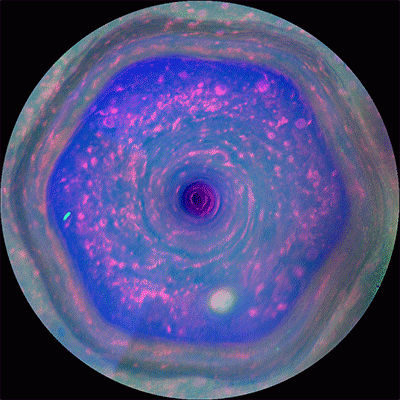Cassini was one of the most ambitious efforts ever mounted in planetary exploration. A joint endeavor of NASA, ESA (the European Space Agency), and the Italian space agency (ASI), Cassini was a sophisticated robotic spacecraft sent to study Saturn and its complex system of rings and moons in unprecedented detail.
Cassini carried a probe called Huygens to the Saturn system. The probe, which was built by ESA, parachuted to the surface of Saturn’s largest moon, Titan, in January 2005—the most distant landing to date in our solar system. Huygens returned spectacular images and other science results during a two-and-a-half-hour descent through Titan’s hazy atmosphere, before coming to rest amid rounded cobbles of ice on a floodplain damp with liquid methane.
Cassini completed its initial four-year mission in June 2008 and earned two mission extensions that enabled the team to delve even deeper into Saturn’s mysteries. Key discoveries during its 13 years at Saturn included a global ocean with strong indications of hydrothermal activity within Enceladus and liquid methane seas on Titan. The mission ended on Sept. 15, 2017.
Mission Science Objectives
Saturn—Study cloud properties and atmospheric composition, winds and temperatures, internal structure and rotation, ionosphere, origin, and evolution
Rings—Observe their structure and composition, dynamical processes, interrelation of rings and satellites, dust and micrometeoroid environment
Titan—Study abundances of atmospheric constituents, distribution of trace gases and aerosols, winds and temperatures, composition and state of the surface, and upper atmosphere
Icy Satellites—Determine their characteristics and geological histories; study mechanisms of surface modification, surface composition and distribution, overall composition and internal structure, and their interactions with Saturn’s magnetosphere
Saturn’s Magnetosphere—Study its structure and electric currents; composition, sources, and sinks of particles within it; dynamics; interaction with the solar wind, satellites, and rings; Titan’s interaction with solar wind and magnetosphere

Cassini's Top Discoveries
Representing just a sampling, some of Cassini’s top accomplishments and discoveries are:
- ESA’s Huygens probe parachuted to Titan, making the first landing on a moon in the outer solar system
- Discovered icy plumes spraying from fractures on Saturn’s moon Enceladus, leading to the understanding that the moon possesses a global ocean of liquid water, likely with hydrothermal activity on the seafloor
- Found Saturn’s rings to be active and dynamic — a laboratory for how planets or moons form
- Revealed Titan to have rain, rivers, lakes, and seas; it is shrouded in a thick, nitrogen-rich atmosphere that might be similar to what Earth’s was like long ago
- Observed the formation and development of Saturn’s great northern storm of 2010–2011, which eventually encircled the entire planet for months
- Revealed radio-wave patterns (known as “SKR”) are not tied to Saturn’s interior rotation, as previously thought
- Imaged vertical structures in the rings for the first time; they appear to be made up of particles piled up in bumps or ridges more than 2 miles (3 km) high
- Studied Titan’s prebiotic chemistry
- Solved the mystery of the dual, bright-dark surface of the moon Iapetus – it is thought that one side of the moon’s topmost ice layer has sublimated (vaporized), leaving a dark, carbon-rich coating on that side while the ice condensed on the other side, making it appear brighter
- Captured the first complete view of the hexagon-shaped jet stream that surrounds Saturn’s north pole and discovered a giant hurricane-like vortex at both of the planet’s poles
Grand Finale
In late 2016, the Cassini spacecraft began a daring set of orbits called the Grand Finale, which were in many ways like a whole new mission. The spacecraft repeatedly climbed high above Saturn’s poles, flying just outside its narrow F ring 20 times.
After a last targeted Titan flyby, the spacecraft dove between Saturn’s uppermost atmosphere and its innermost ring 22 times. As Cassini plunged past Saturn, it collected rich and valuable information far beyond the mission’s original plan, including measuring Saturn’s gravitational and magnetic fields with ultrafine precision, determining the mass of the rings, directly sampling the atmosphere and ionosphere, and capturing incredible up-close views of the planet and the rings.
On Sept. 15, 2017, the spacecraft made its final approach to the giant planet. This time, Cassini dived into the planet’s atmosphere, sending science data for as long as its small thrusters could keep the spacecraft’s antenna pointed at Earth. Soon after, Cassini burned up and disintegrated like a meteor in the skies high above Saturn’s clouds.
Although the spacecraft may be gone, its enormous collection of data about Saturn – the giant planet itself, its magnetosphere, rings and moons – will continue to yield new discoveries for decades.
NASA’s Cassini spacecraft and ESA’s Huygens probe expanded our understanding of the kinds of worlds where life might exist and eight more reasons the mission changed the course of planetary exploration.





